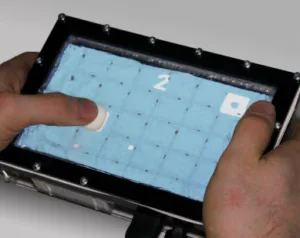There are many applications in which the availability of a touchscreen greatly enhances a user’s ability to interact with program content. None-the-less, the smooth surface of a touchscreen makes it less suited for use in conjunction with some tasks such as those in which the user’s eyes are occupied away from the display. To address this issue, a multi-organizational team of researchers at the Quality and Usability Lab, Telekom Innovation Laboratories, Technische Universität Berlin (Berlin, Germany) is developing means to produce soft, temporary buttons that can be of almost any fixed shape, size and location on a touchscreen surface. The technology under development by the team is both interesting and different from other approaches that have been reported.

A recent article by the team is entitled “GelTouch: Localized Tactile Feedback Through Thin, Programmable Gel.” The paper is scheduled to be presented at the 28th ACM User Interface Software and Technology Symposium to be held in Charlotte, NC between November 8th and 11th. A copy of the article is available on-line and can be found here.
The technology developed by the team integrates a layer of thermo-responsive hydrogel beneath the touch panel. Hydrogel is a polymer having a three-dimensional network that swells in water. The gel is fluid-like and transparent at room temperature. The material has the property that, when heated above 90°F (32°C), water evaporates changing the gels viscosity. As a result, the gel shrinks, making it up to 25 times stiffer. The gel also turns white.
In a GelTouch device, a shaped, transparent layer of ITO is placed beneath the gel layer. To “activate” the gel, an electric current is sent to the ITO electrode(s). The electrode is used to heat the gel causing it to expand and stiffen in a predefined shape. The result is a temporary button just beneath the surface of the display. When the electrical current is turned off, the gel cools and the buttons retract.
Ideally, the gel should be kept just below or above the so-called lower critical solution temperature to ensure quick activation and deactivation. In the existing prototype, it takes about two seconds to harden once heat is applied and about the same amount of time to soften.
GelTouch technology can be used to produce a variety of button layouts. The article discusses three implementations. To make high-resolution shapes, areas are etched in the ITO creating so-called “taxels.” It is also possible to stack multiple shaped ITO layers beneath the gel, each layer having the ability to be heated individually. In this way several different button shapes can exist in the same spot. A third approach is the use of a three-dimensional arrangements of resistance wire. This approach can be used to create thin, tactile edges.
Using GelTouch, the team has produced a 7-inch prototype touchscreen that consists of a 6 x 4 array of rectangular touch pads. The touchscreen is 2 mm thick. Operation of this device is illustrated in a video that can be found at the end of this article. Other proof-of-concept patterns include a slider and a joystick-like stub.
There are still a number of problems that need to be addressed before GelTouch is ready for commercial applications. These include the following:
- The gel must be continuously heated to remain activated. As a result, the required continuous application of current could result in undesirably high power consumption.
- The time lag to transition between soft and hard states may be undesirably long for some applications. Increasing the rate of cooling may be a particular challenge.
- Since the gel is not transparent when activated, it may obscure the image presented on the display thus creating the potential for actually making some applications more difficult to use.
- Means need to be developed to assure that GelTouch’s temporary buttons do not continue to expand when activation continues for a long period of time or as a result of heat transferred from surrounding activated areas.
- There may also be an issue associated with the fact that the surface of a GelTouch enabled touchscreen is soft. This may be unfamiliar and, at least initially, considered undesirable by users familiar with conventionally stiff touchscreen surfaces.
Despite this formidable list of problems, the GelTouch technology has demonstrated interesting potential. Based on comments made by team members, there seems to be opportunities for progress in addressing each problem area. -Arthur Berman
Technische Universität Berlin, Viktor Miruchna, [email protected]

